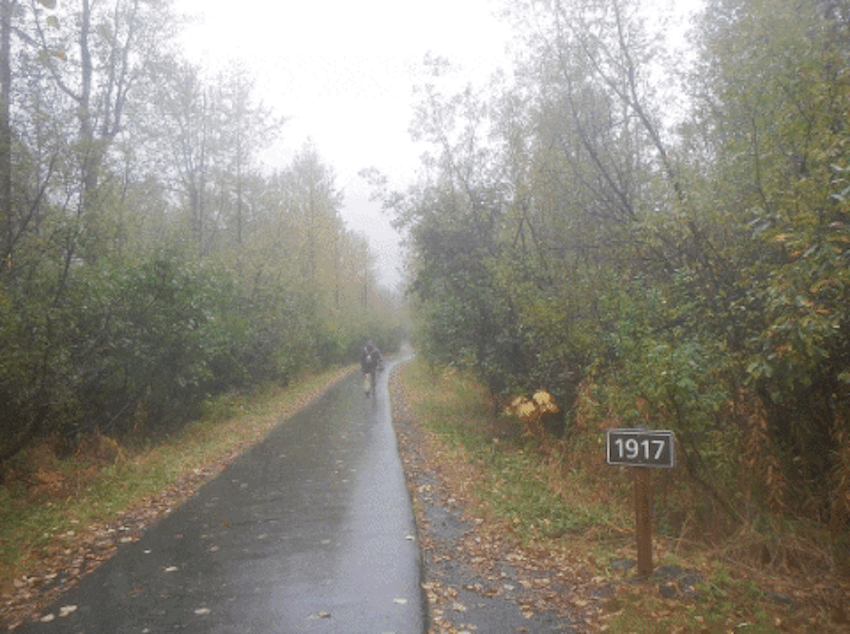Want a peek at our hotter future? Go to Alaska
Alaska, heating up twice as fast as the rest of the world, is the next best/worst thing to a climate-change time machine.
SEWARD, Alaska — Drip.
Drip.
Drip.
It's the sound of one glacier melting.
It’s also the sound of a whole planet careening into uncharted territory.
I am crouching by the mouth of a little ice cave underneath the Exit Glacier, a huge river of ice on the Kenai Peninsula in southcentral Alaska. Ancient ice drips from the roof of the cave onto newly bare earth. Twice in a few minutes, I hear rocks fall from the freshly exposed landscape at the glacier’s snout and decide this is not the safest place to be.
Like glaciers and ice caps around the world, the Exit has been retreating dramatically, helping to raise sea levels from Miami to Mumbai.
Sponsored
Retreating glaciers are just one of many ways Alaska has already been profoundly changed by our warming climate.
The state is warming twice as fast as places farther south. If you want glimpses of our hotter future, Alaska is the next best thing to a time machine.
In much of the state, air and water temperatures are shattering records. Rainforests are suffering droughts. Coastal villages are relocating inland. Sea birds are dying off. Wildfires burn for months.
Walk a mile in a glacier's shoes:

“With climate change, we have a huge erosion problem,” Gayla Hoseth with the Bristol Bay Native Association in Dillingham said. “For instance, where the hospital is, that bank used to go way out. There used to be a road. That road is no longer there.”
Deana Harms of Montana is one of 580 firefighters from around the country working on one of Alaska’s biggest wildfires, the Swan Lake fire. The fire has brought choking smoke to Kenai Peninsula communities and Anchorage since June.
“You know it's really dry here,” she said, “so these little spells of rain have been helping, but the moisture is not really penetrating deep into the ground where it would help for the fire to go completely out.”
In a state where people hunt and gather much of their own food, the heat in recent years has made it more difficult to put food on the table.
The isolated village of Igiugig sits on Alaska’s biggest lake, with soggy tundra all around, but no roads. Around Lake Iliamna, travel by snowmobile is key.
Sponsored
“We're an island when it comes to swamp lands around us, and you need to wait till the freezes, obviously, to get anywhere,” said AlexAnna Salmon, president of the Igiugig Village Council.
Her sister, Christina Salmon, who sits on the village council, said nothing froze last winter.
“Oftentimes we need to get across to hunt for caribou over there,” Christina Salmon said. “But none of the guys could get over there because all of the creeks and ponds were open. The lake didn't freeze at all. People are boating in March. It's unheard of.”
Just like in the Washington Cascades, winters have been bringing less snow and more rain.
Christina Salmon said this year’s drought has slashed local berry harvests. Some berries like cloudberries, a tundra delicacy, are ripening weeks sooner, now competing with fishing season. People have to choose: catch salmon or gather fruit.
Sponsored
“It's really hard for me because I love the act of putting away food for my family for the winter,” she said. “It's something I've loved since I was a little girl in fish camp with my grandma.”
More than half the world’s sockeye salmon come from the region that the Salmon sisters call home, Bristol Bay.
Some parts of Alaska have reported poor salmon returns and even fish die-offs as rivers have been too hot for salmon to want to head upstream.
The water temperature in one salmon stream north of Anchorage hit a freakish 81 degrees.
Perhaps oddly for a cold-water fish like salmon, warmer waters seem to be helping some Bristol Bay runs: A staggering 55 million sockeye, a near record, returned to the bay this summer.
Daniel Schindler with the University of Washington has spent the past 22 summers on remote Lake Nerka above Bristol Bay, studying those fish.
Sponsored
“The last few decades the lakes have warmed up,” he said. “Fish are growing faster and they seem to have higher survival rates when they head to the ocean.”
The question is, how much more warming can the sockeye handle before they decline too?
Schindler said we shouldn’t make too much of salmon dying in Alaska’s heat wave this summer.
“It's clear that lots of fish died,” he said. “But as a proportion of the run that returned to those rivers, I think it's a pretty small fraction.”
From diesel generators to float planes, rural Alaska depends on oil more than most.
Sponsored
With the state’s government running on oil taxes, transitioning away from fossil fuels could be especially wrenching here.
Alaska Gov. Mike Dunleavy has emphasized slashing government spending, not climate-harming pollution.
But the tiny, diesel-dependent village of Igiugig (population: about 70) has installed wind turbines and is one year into a pilot project with a new form of hydropower. The village has plunked an experimental turbine in the depths of the Kvichak River to produce climate-friendly electricity without blocking the clouds of salmon that swim past it.
Can people outside Alaska fend off the disruptions that the northernmost state is already living through? That mostly depends on the rest of us getting serious about ending our fossil fuel use, too.
CORRECTION 9:00 p.m., 9/20/19: A previous version incorrectly attributed a statement by AlexAnna Salmon to her sister, Cristina Salmon.
Reporting from Alaska made possible in part by the Institute for Journalism and Natural Resources.




